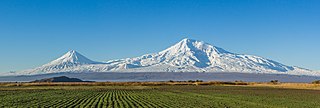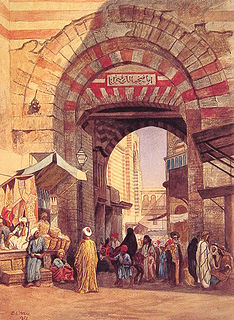This page is based on this
Wikipedia article Text is available under the
CC BY-SA 4.0 license; additional terms may apply.
Images, videos and audio are available under their respective licenses.

Yuen Long District is one of the districts of Hong Kong. Located in the northwest of the New Territories, it had a population of 449,070 in 2001. The district has the youngest population of Hong Kong.
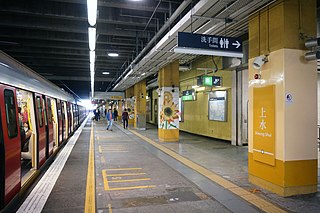
Sheung Shui is the penultimate northbound station on the East Rail Line in Hong Kong. This station serves as the terminus of northbound trains after the Lo Wu and Lok Ma Chau boundary crossings have closed for the day. Passengers wishing not to enter the Boundary Area illegally by proceeding to Lo Wu or Lok Ma Chau without a Closed Area Permit, valid passport, and visa must disembark here.

Fanling is a station on the East Rail Line of the Hong Kong MTR. It is next to Fanling Town Centre, and is only a short walk away from Fung Ying Seen Koon, a well-known Taoist temple. The Fanling Highway was built from 1983 to 1987 directly adjacent to the station. The station is located on Fanling Station Road within the Fanling area in North District, New Territories, Hong Kong.
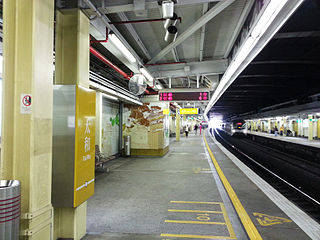
Tai Wo is a MTR station in the western part of Tai Po New Town, in New Territories, Hong Kong. The station is located on the East Rail Line, between Fanling and Tai Po Market stations.

Sheung Shui is an area in the New Territories, Hong Kong. Sheung Shui Town, a part of this area, is part of the Fanling-Sheung Shui New Town in the North District of Hong Kong. Fanling Town is to its southeast.

Tai Po is an area in the New Territories of Hong Kong. It refers to the vicinity of the traditional market towns in the area presently known as Tai Po Old Market or Tai Po Kau Hui (大埔舊墟) on the north of Lam Tsuen River and the Tai Po Hui on Fu Shin Street on the south of the Lam Tsuen River, near the old Tai Po Market railway station of the Kowloon-Canton Railway. Both market towns became part of the Tai Po New Town in the late 1970s and early 1980s. In present-day usage, "Tai Po" may refer to the area around the original market towns, the Tai Po New Town, or the entire Tai Po District.

Pat Heung is an area in the middle of New Territories, Hong Kong. Located at the east of Kam Tin and north of Shek Kong, it is the exit to Sheung Shui and Fanling. Administratively, it belongs to Yuen Long District.
The generic forms of Hong Kong place names are mainly Cantonese, Hakka and British English, although other languages also contribute to Hong Kong place names.

Tai Po New Town, or Tai Po Town, is a new town and non-administrative area in Tai Po District, in the New Territories, Hong Kong. The area is a planned town that surrounding the existing indigenous market towns Tai Po Hui and Tai Po Kau Hui, as well as east of the existing indigenous villages that located on the Lam Tsuen Valley as well as west of those villages in Ting Kok and Tai Mei Tuk and south of those villages in Nam Hang, Fung Yuen and Sha Lo Tung. Most of the lands of the new town were obtained by land reclamation. In present day, Tai Po New Town was simply known as Tai Po. The new town are largely covered by the government Tai Po Outline Zoning Plan, which legally regulated the land use of the area, on top of the terms in the land lease contract with the government. Some of the land lease within the area, were known as Tai Po Town Lot № foo. In election, the town had a different zoning scheme for the election constituencies.

Shap Pat Heung is an area in the New Territories of Hong Kong. Located south of Yuen Long and northeast of Tai Tong, the area occupied the plain north of hills of Tai Lam. The Cantonese name Shap Pat Heung means eighteen villages at its beginning. It was later expanded to thirty villages. Administratively, it is part of the Yuen Long District.
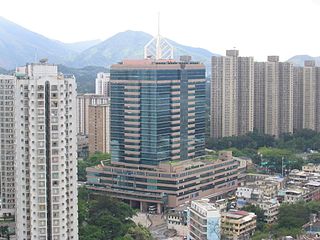
Landmark North is an office tower-and-shopping centre complex in Sheung Shui, Hong Kong. It was developed by Sun Hung Kai Properties and is located in the commercial centre of Sheung Shui.

Lam Tsuen Country Park (林村郊野公園) is a 15.20 km² country park in the northern New Territories, in Hong Kong.
Tai Po Market or Tai Po Hui is the name of the non-administrative area within the modern day Tai Po New Town in the Tai Po District, in the New Territories, Hong Kong. However, its exact location changed from time to time. It is considered as the town centre of the non-administrative area known as just Tai Po. The area was established as a market town, which closely related to the modern day residential and commercial area Tai Po Old Market and had some relation with the present-day area Tai Wo. However, all three area are not overlap, and divided by Lam Tsuen River or Tai Po Tai Wo Road. Tai Po Market, Tai Po Old Market and Tai Wo Estate are all within modern day Tai Po New Town.

The Hong Kong government started developing "New Towns" in the 1950s, in order to accommodate Hong Kong's booming population. At the first phase of development, the newly developed towns were called "satellite town", a concept borrowed from the United Kingdom, of which Hong Kong was then still a colony. Kwun Tong, located at eastern Kowloon, and Tsuen Wan, located at the south-west New Territories, were designated as the first two satellite towns, when the urban area in Hong Kong was still relatively small, restricted to the central and western part of Kowloon Peninsula and the northern side of Hong Kong Island. Wah Fu Estate was also built in a remote corner at the southern side of Hong Kong Island, with similar concepts in a smaller scale.

Shek Wu Hui is a non-administrative subdivision (neighbourhood) and former indigenous market town located in Sheung Shui in the North District of Hong Kong. The place name can be found in the record that published in 1819.
